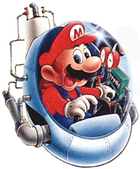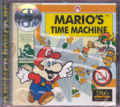Mario's Time Machine: Difference between revisions
| Line 115: | Line 115: | ||
File:TimeMachineImage65.jpg|Mario in Orleans. | File:TimeMachineImage65.jpg|Mario in Orleans. | ||
File:BowserTimeMachine65.jpg|Bowser appears. | File:BowserTimeMachine65.jpg|Bowser appears. | ||
File:MTM Paradise.png|Paradise, the place where Bowser makes his escape. | File:MTM Paradise.png|Ending #3: Paradise, the place where Bowser makes his escape. | ||
File:EndingMachine65.jpg| | File:EndingMachine65.jpg|Ending #2: The text indicates that the player made a mistake. | ||
</gallery> | </gallery> | ||
Revision as of 21:45, May 22, 2013
Template:Infobox Mario's Time Machine is an edutainment title developed by Radical Entertainment that was released for the SNES and PC in December 1993; it was later released on the NES on April 23, 1994[1]. It is meant to teach younger players basic world history and is the last Mario Discovery Series game before discontinuation. This game and Hotel Mario are the only games in the Mario series in which Mario as a protagonist has full lines of dialogue.
Story
In the year 1993, Bowser builds a time machine called the Timulator, which he uses to travel backwards to different points in human history and steals significant artifacts to place in his personal museum. Mario must take back the artifacts and return them to their proper places in time before history becomes irreversibly damaged.
In the NES version of the game, Yoshi joins Mario in his quest to stop Bowser's plot, but instead gets captured. In addition to fixing the timeline Mario must also rescue Yoshi from peril.
Gameplay
SNES
The central hub of Mario's Time Machine is the museum within Bowser's Castle. The museum is three floors high, and on each floor lies five artifacts, giving Mario a total of fifteen periods of time to travel to. Mario must take an artifact from a pedestal, look at the date and location labeled on it, and then program that information into the Timulator and travel to that point in the timeline.
When the player arrives in the time period, he must explore and converse with the various residents that live there. In doing so, the player learns about the artifact, the time period, and the person associated with it. To get more information, the player must receive items that some residents possess and give them to others in order to satisfy their needs. For example, in Vienna one resident will complain about the heat until Mario retrieves a fan and hands it to the person, who will then continue to give information. After the player has talked to everyone, the player fills out a History answer sheet. The answer sheet consists of a two-page biography about the person associated with the artifact and the time period, with blanks replacing several words. The player must use the information he received to correctly fill in the blanks. If the player fills in the wrong answer more than twice, the player is forced back into the present. If he succeeds, Mario can return the artifact to its owner and return back to 1993.
After all the artifacts of a floor have been returned, Mario moves upward to the next floor.
A timer and a hidden Checklist are used throughout the game. How long the player spends in each time period and the order in which he returns each artifact will total up to one of three different endings. If the player spends too much time returning all the artifacts or returns even ONE artifact in the wrong order, Bowser escapes to "Paradise" using the Timulator; then the player must start over from the beginning, or use a password to go back to a previous point. However, if they meet the two objective conditions, the Timulator overloads, self-destructs and sends Bowser to the Jurassic period where he gets stepped-on by a Tyrannosaurus Rex.
Time periods
The time periods that Mario visits in each version varies. Here is a chart of the location and artifact for the NES, SNES, & PC versions in chronological order.
NES
- 80M BC — (Egg)
- 776 BC — (Torch)
- 31 BC — (Throne)
- 1192 — (Sword)
- 1520 — (Steering Wheel)
- 1602 — (Quill Pen)
- 1687 — (Apple)
- 1862 — (Stovepipe Hat)
- 1879 — (Light bulb)
- 1903 — (Propeller)
- 1905 — (Physics Equation)
- 1947 — (Flag)
- 1969 — (Flag [United States])
- 1989 — (Sledgehammer)
SNES
- 369 BC — Athens (The Republic book)
- 47 BC — Alexandria (Royal Staff)
- 1292 — Gobi Desert (Printing Block)
- 1429 — Orleans (Shield)
- 1455 — Mainz (Printing Machine)
- 1503 — Florence (Chisel)
- 1505 — Florence (Papers)
- 1521 — Pacific Ocean (Globe)
- 1595 — England (Queen Elizabeth the First's Crown)
- 1601 — Stratford upon Avon (Skull)
- 1687 — Cambridge (Apple)
- 1776 — Philadelphia (Declaration of Independence)
- 1824 — Vienna (Music Sheet)
- 1879 — Menlo Park (Filament)
- 1947 — Calcutta (Indian Flag)
PC
- 369 BC — Athens (Plato's "Republic" Book)
- 47 BC — Alexandria (Cleopatra's Royal Staff)
- 105 AD — Luoyang (T'sai Lun's Bamboo)
- 1292 — Gobi Desert (Marco Polo's Printing Block)
- 1429 — Orleans (Joan of Arc's Shield)
- 1455 — Mainz (Johann Gutenburg's Printing Machine)
- 1503 — Florence (Michaelangelo's Chisel)
- 1505 — Florence (Leonardo Da Vinci's Papers)
- 1521 — Pacific Ocean (Ferdinand Magellen's Astrolabe)
- 1595 — London (Queen Elizabeth the First's Crown)
- 1601 — Stratford-Upon-Avon (William Shakespeare's Skull)
- 1610 — Padua (Galileo's Telescope)
- 1687 — Cambridge (Sir Isaac Newton's Apple)
- 1752 — Philadelphia (Ben Franklin's Key)
- 1776 — Philadelphia (Thomas Jefferson's Declaration of Independence)
- 1791 — Vienna (Wolfgang Mozart's Flute)
- 1824 — Vienna (Ludwig Van Beethoven's Music Sheet)
- 1831 — London (Michael Faraday's Magnet)
- 1843 — London (Charles Dickens' Inkwell)
- 1863 — Washington (Abraham Lincoln's Glasses)
- 1879 — Menlo Park (Thomas Edison's Filament)
- 1885 — Paris (Louis Pasteur's Flask)
- 1915 — Tuskegee (George Washington Carver's Crank Handle)
- 1947 — Calcutta (Mahatma Gandhi's Indian Flag)
- 1994 — Novato (Software Toolworks' Floppy Disk)
Reception
Since its release, Mario's Time Machine has received negative reception. It holds an aggregate score of 60.25% on Game Rankings based on two reviews. Nintendo Power gave it a 2.65 out of five, while Electronic Gaming Monthly gave it a slightly better rating of 6.75 out of 10. GameSpy's Brian Altano and Brian Miggels criticized its ending (considered to be one of the worst video game endings ever) for its depiction of Bowser crying, while Mike Drucker, also a GameSpy editor, called it "half-assed." Gamesradar commented that fans of the game would be fans of Night at the Museum: Battle of the Smithsonian, to which Gamesradar also gave a negative review. Later, they mentioned that Mario's Time Machine was unpopular, commenting that "five, maybe six people played the NES version of Mario’s Time Machine". ABC Good Game called it "awful," and they considered it to be "way too complicated for any school-aged youngster to understand." In the book Video Games: A Guide for Savvy Parents, author David Sheff praised the educational elements but criticized the gameplay. Andy Slaven, author of the book Video Game Bible, 1985-2002, accused the game of ripping off Where in Time is Carmen Sandiego? He admitted that the game was not bad in and of itself, but he stated that it was a poor educational game.
References to other games
- Mario Bros.: The method of collecting objects in the Nintendo Entertainment System version involves defeating three Koopa Troopas in a style similar to this game. Unlike in the original game, the pipes are able to be entered by Mario, and can be used to exit to the main part of the museum.
- Super Mario Bros. 3: Bowser's sprite in the NES version appears to be a modified version of his sprite from this game.
- Super Mario World: Most of the other sprites in the NES version, including those for Mario, Yoshi, and the Koopas, are those from this game, though modified for an 8-bit system. A number of other assets directly reference this game, such as the opening where Mario and Yoshi walk up to Bowser's Museum, which is identical to the cutscene shown before Mario enters a Ghost House or Castle, expect Yoshi runs inside the museum after Mario dismounts him rather than waiting outside.
Gallery
- TimeMachineScreen.png
The title screen of the NES version
- TitleScreenMachine65.jpg
The title screen for the SNES version.
- Bowsertimemachine.PNG
Bowser and his minions with the Timulator.
- Ss mtm-snes surf.gif
Mario 'Time Surfing'.
- TimeMachinePhiladelphia65.jpg
Mario returns the Declaration of Independence.
- TimeMachineImage65.jpg
Mario in Orleans.
- BowserTimeMachine65.jpg
Bowser appears.
- EndingMachine65.jpg
Ending #2: The text indicates that the player made a mistake.
Staff
- Main article: List of Mario's Time Machine staff


